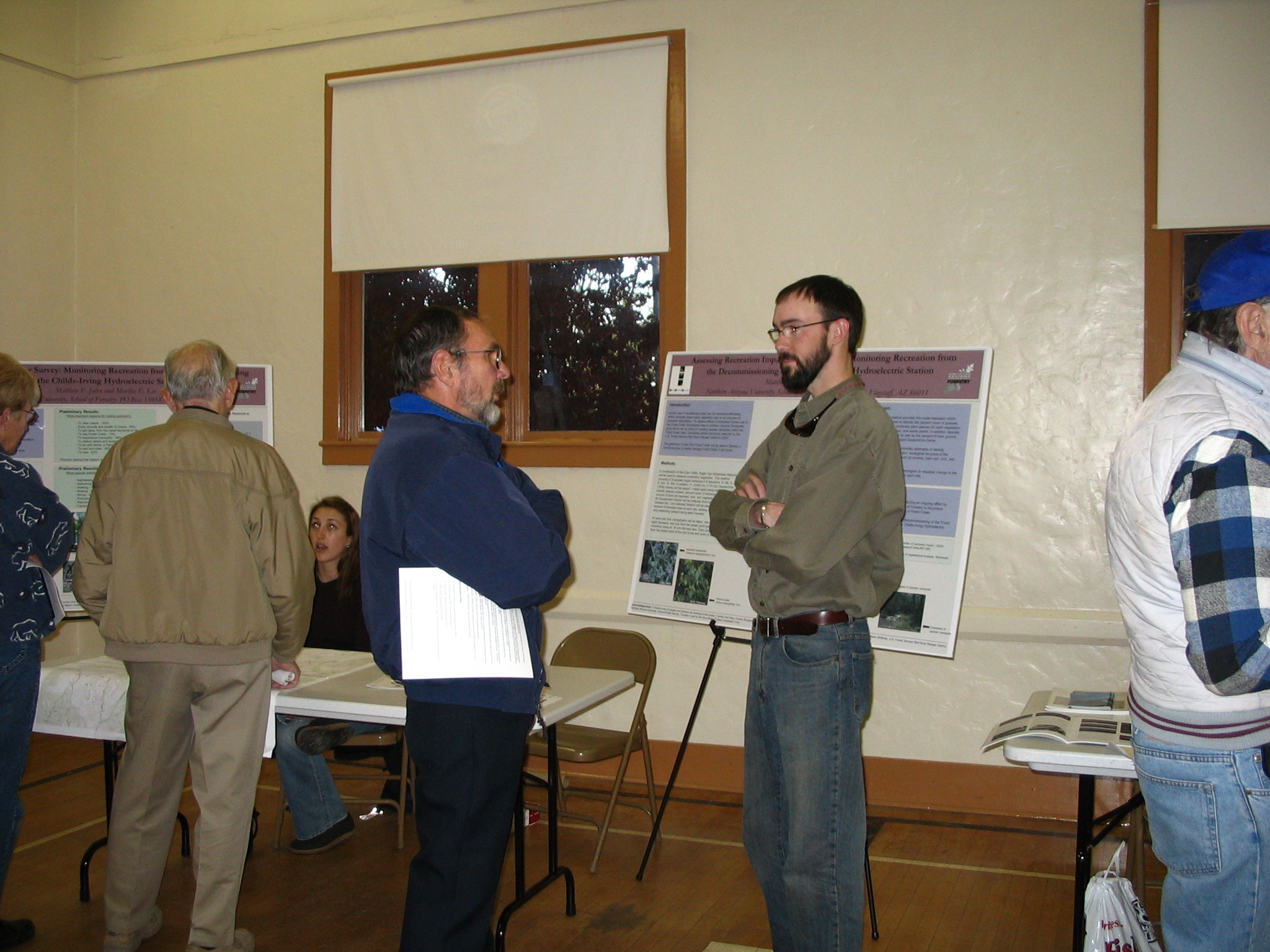|
Fossil
Creek Watershed
and Riparian Restoration
Participatory Meetings

Northern Arizona
University is working to ensure that the public as well as all entities
conducting activities at Fossil Creek know what research and monitoring
activities are on-going and planned at Fossil Creek.
In an effort to do this, NAU has held four stakeholder participatory
meetings to date. The first was held on June 1, 2004, and the latest was
held on October 26, 2005. Below are summaries of these meetings with
the most recent meeting summarized first:
Our fourth participatory meeting
was held on October 26, 2005 at the Southwestern Academy. The Fossil Creek
Stewardship Meeting was designed to bring together managers, researchers,
environmentalists, tribal leaders, and interested citizens to talk about
future management of Fossil Creek, specifically the short- and long-term
management, stewardship, and education/outreach needs for Fossil Creek.
Below is a summary of the meeting. A complete summary of the meeting can be
found in the meeting notes, available to download in Word or PDF form on
this page.
Forty-two people were invited to attend the meeting organized by the NAU
Fossil Creek Ecosystem Studies Group. Attendees were invited to participate
in a discussion of the short- (1-3 years) and long-term needs for Fossil
Creek. We asked them to think about three questions we would discuss at the
meeting:
1. What are the short- and long-term management needs for Fossil Creek?
Management in this context has to do with actions by agencies responsible
for managing Fossil Creek and its resources.
2. What are the short- and long-term stewardship needs for Fossil Creek?
Stewardship has to do with broadly defined actions and commitments to care
for and protect Fossil Creek that include individuals and communities.
3. What are the short- and long-term education and outreach needs for Fossil
Creek?
Twenty-four people participated
in the meeting. We used a facilitated nominal group process to identify and
rank responses to the questions. We broke participants into three groups
with each having a mix of researchers and managers from the various land and
wildlife management agencies, non-profit group members, tribal leaders, and
interested citizens. Each group included a facilitator and a recorder.
Notable Highlights
Short-Term Management Needs:
• recreation management to enhance experiences and reduce impacts
• collaborative, interagency management and monitoring
• protection of native fish (e.g., crayfish control, enforcing regulations,
developing a monitoring plan)
Long-Term Management Needs:
• maintain native fisheries (control of crayfish, non-natives)
• management of recreation infrastructure, including roads, trails,
motorized access
• acquiring funding and additional human resources
• management presence/law enforcement
Short-Term Stewardship Needs:
• formation of a stewardship group – Friends of Fossil Creek
• form relationships with other existing stewardship groups
• collaborative planning
• keep the area clean
• provide stewardship information to users
Long-Term Stewardship Needs:
• Friends of Fossil Creek and agency interaction
• keep the area clean
• consider user fees
• law enforcement
• increase volunteerism (e.g., in local communities, school groups)
Short-Term Education/Outreach Needs:
• On-site information sharing targeting users
• media – kiosks, on-site hosts, displays
• topics – Leave No Trace, stewardship, Fossil Creek story, preserving
native fish
• Off-site information sharing – schools, communities, seek volunteers
• Share information within and among agencies
Long-Term Education/Outreach Needs:
• education of visitors and locals about stewardship, ethics, Leave No Trace
• education on native fish to prevent reintroduction of non-natives
• gathering and sharing information on Fossil Creek research and management
with the public via symposia, liaison, surveys
View the October 26, 2005 meeting notes:
Word
document (793 KB)
PDF
(146 KB)
Our third participatory meeting was held on
April 14, 2005 in Camp Verde, Arizona. This meeting was geared toward
providing updates to, and soliciting feedback from, conservation groups and
tribes. Participants included representatives from the Yavapai Apache
Tribe, Friends of Arizona Rivers, the Sierra Club, Northern Arizona Audubon,
and several individuals with long-term involvement in the restoration of
Fossil Creek. At the two-hour meeting, NAU provided an overview of
research and inventory at Fossil Creek and an overview of NAU's Stream
Ecology and Restoration Group's research at Fossil Creek (titled "Fixing
Broken Ecosystems"). The group
discussed the research and monitoring taking place at Fossil Creek, and
management issues associated with the predicted increase in recreational use
of the area.
View the April 14, 2005 meeting notes:
Word document (36.5 KB)
PDF (39.2 KB)
View the slide show presentations:
Please note that these are large PDF files and will take some time to
download if you have a dial-up connection.
Fossil Creek Overview Slide Show (Charles Schlinger, NAU) PDF (5.38 MB)
Fixing Broken Ecosystems Slide Show (Jane Marks, NAU) PDF (7.27 MB)
Our second set of participatory meetings
were held on October 29 and 30, 2004 in Pine
and Camp Verde, Arizona. These open houses were geared toward providing
information to the public about on-going and up-coming research, fish restoration, and
decommissioning activities at Fossil Creek. Information was provided
from 5 NAU research programs, the U.S. Fish and Wildlife Service, and APS.
Nearly 50 members of the public attended these two open houses.
The first
participatory meeting was held on June 1, 2004 and invitees were limited to
agencies and entities directly involved in on-going work at Fossil Creek.
Participants included the U.S. Forest Service, U.S. Fish and Wildlife
Service, NAU, U.S. Bureau of Reclamation, APS, and Northern Arizona Audubon
Society.
View the June 1, 2004 meeting notes:
Word document (101 KB)
PDF (95 KB)
Overview
Baseline Conditions
Long-Term Plan
Facility Decommissioning
Management Recommendations
Fossil Creek Info
Native Fish Restoration
Research
Photos
Links
|
